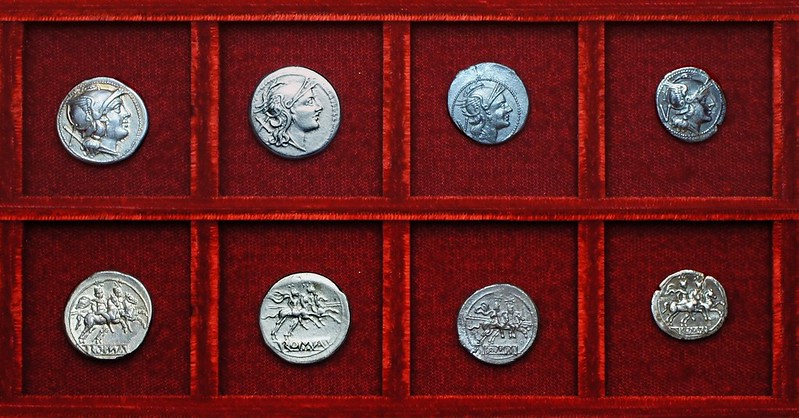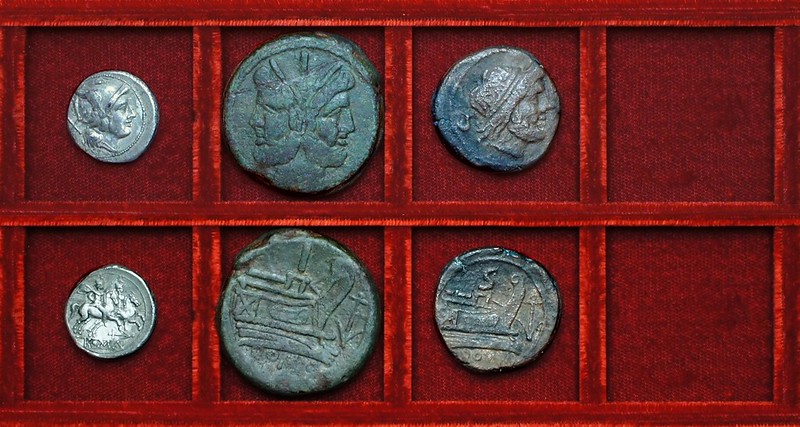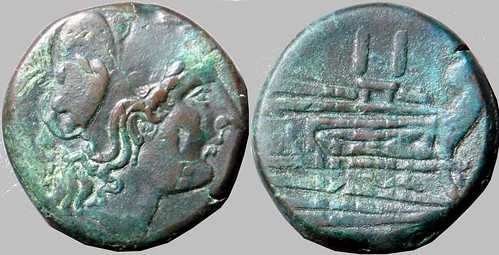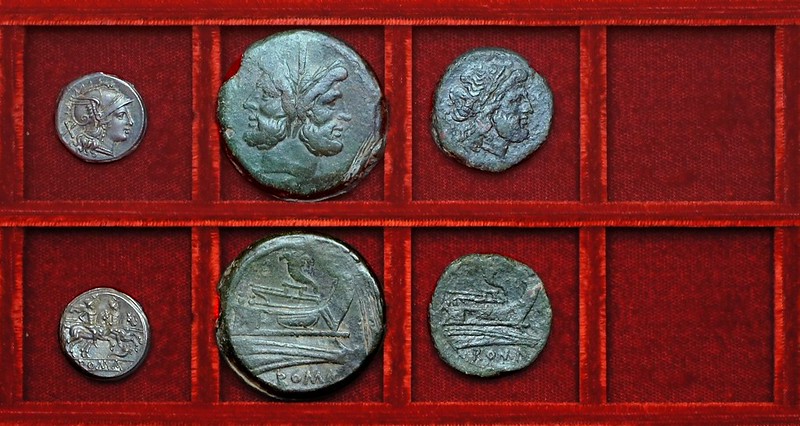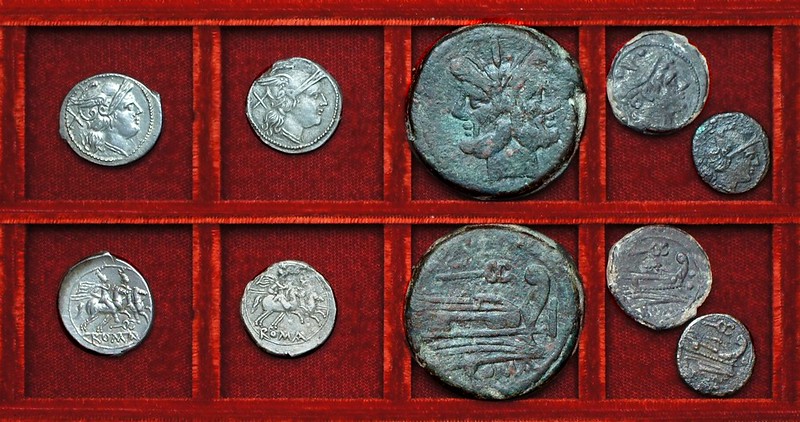Part 3 RRC 44 to RRC 66, 214 to 207BC, First Denarius coinage in Italy and Sardinia
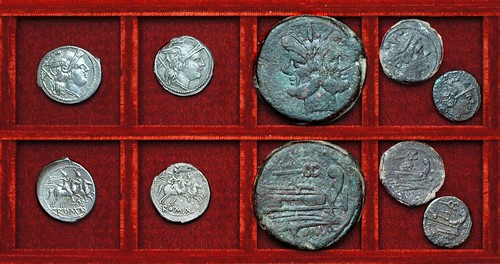
|
Specialist Supplements:
1. Roman Coins of Luceria and Canusium
2. Anonymous Struck Bronze Coins of the Roman Republic
3. Anonymous Roman Republican Denarii and Victoriati (Steve Brinkman's site)
Principal Coins of the Roman Republic
Part 3 RRC 44 to RRC 66, 214 to 207BC, First Denarius coinage in Italy and Sardinia
RRC 44 Mars Eagle Anonymous gold 60 and 20 As, RRC 44 anonymous silver Denarius and Victoriatus. For a full discussion on the anonymous silver coinage of the second Punic war and later, please see Steve Brinkman's website, made in collaberation with Pierluigi Debarnardi, that covers the anonymous denarius, and will soon be extended to also cover the anonymous victoriatus, based on a 2009 Celator article by Kenneth Friedman and Richard Schaefer.
RRC 44 anonymous Denarii and Quinarii. The second quinarius, at right, has a dot under the obverse head which Pierluigi Debarnardi believes to be a mintmark as it occurs on several denominations and also on the quadrigatus coinage.
RRC 44 anonymous Sestertii, RRC 47 anonymous Quinarius. The brockage sestertius is a particularly nice example.
RRC 44 anonymous denarius. The style of this coin is akin to the middle two sestertius at left in the prior picture.
RRC 45 incuse-legend denarius, and the related RRC 45 anonymous quinarius and sestertius, RRC 46 anonymous denarius. Mommsen considered the incuse legend denarius, which is of the highest rarity, to be the first Roman denarius.
RRC 50 anchor denarius as, semis.
RRC 51 M denarius, RRC 53 anonymous denarius. The anonymous type is of a different style to either of those shown in the red tray below. I aim to illustrate a range of styles of the anonymous silver and bronzes of the second Punic war period. Steve Brinkman's website illustrates all known styles.
RRC 53 anonymous denarii, RRC 54 anonymous denarius. The coin at centre is of particularly fine style and strike. As with RRC 44, anonymous RRC 53 denarii come in a wide range of styles and engraving quality.
RRC 56 anonymous bronzes. I illustrate a range of anonymous bronzes. The first as is McCabe group C2, related to RRC 80 dolphin. The second as and the quadrans are McCabe group C1/C3, related to RRC 89 club. Effectively these are anonymous issues related to these signed series. The first two asses both weigh over 50 grams. Both are otherwise of very similar manufacture, and hybrid types that mix design elements of both series are known, hence I believe them to be from one mint, perhaps near Tarentum in south Italy. The third As is of McCabe group D that is related to RRC 50 anchor. It is an especially well made coin.
RRC 56 anonymous bronzes, McCabe group G1. McCabe group G is unrelated to any bronzes with symbols or letters, and I believe to be from Rome. Coins of group G1 were produced to particularly high technicals standards on well-made broad flans. I show a range of denominations these attractive coins.
RRC 56 anonymous semis, triens and sextans McCabe group G2, uncia and semuncia of McCabe group G1. Group G2 coins always have a kinked-back prow stem and unsmiling downward looking expressions on the obverse busts. A die-link is known between group G1 and G2 coins, hence establishing a sequence. The small uncia and semuncia may be either group G1 or G2 - on such tiny coins it's effectively impossible to distinguish facial expressions and the exact form of the end of the prowstem.
RRC 56 anonymous semis, triens, quadrans, uncia McCabe group G3. Group G3 is the third in the Rome mint series, and have long, low-angle prowstems. This is the last coin series in which very large volume production of the uncia takes place. From this point onwards, unciae and semunciae are rare in Roman coinage. The triens is double struck, giving the incorrect impression of an elongated bust of Minerva and a prow with no superstructure, but the dies are essentially of regular style.
RRC 56 dupondius anonymous Minerva Prow, McCabe group H2, courtesy Dominique Hollard and Michel Amandry, BNF Paris. All the Minerva Prow Dupondius types are overstrikes on existing Roman Asses and they appear to be a short-lived Punic war experiment. Almost all known examples come from a couple of finds, and are unworn, suggesting they hardly circulated and may have been withdrawn. The obverse engraving style is particularly fine.
RRC 56 anonymous triens and uncia, McCabe group H1 various styles. These lightweight coins of McCabe group H are often seen to be overstruck on Punic bronzes. They are otherwise well made and of good style, and their styles mimic one or other full weight anonymous bronze types of the era. Because of their light weight they are often mistakenly believed to be of a later perhaps semuncial era, or to be imitative, but they are clearly official and of the second Punic war period. The great majority of these coins are trientes and sextantes, but semisses and unciae are also known. These lightweight but good style coins do not appear in excavation contexts in Rome suggesting they were made outside Rome and/or they had limited circulation life. Many are found in excellent condition which reinforces the impression that they had limited circulation and were perhaps not widely accepted.
RRC 57 crescent victoriatus, denarius, semis, triens. The denarius is exceptional. Crawford placed RRC 57 at the very end of the first group of second Punic war coins
RRC 58 cornucopia denarius, as and semis. The engraving on the As is of particularly fine style, reminiscent of the fine style RRC 43 struck semis of the Luceria L mint. The denarius is also exceptional.
RRC 59 apex and hammer, denarius, as, lightweight semis, triens, quadrans, uncia. The semis is lightweight but of good style; in the series apex and hammer, caduceus and Victory, good style but lightweight semisses, trientes, quadrantes and sextantes occur frequently. I have been told that die matches exist between the heavy and light coins.
RRC 60 caduceus denarius, anonymous denarius, as, sextans and uncia. The as and sextans weigh considerably more than the sextantal standard, at 60 grams and 72 grams as-equivalent respectively. This is not unusual for heavy coins of the apex and hammer, caduceus and Victory issues, which are often just as big and heavy as lighter coins of the Rome mint post-semilibral coinage (McCabe group A2). The caduceus uncia is a particularly fine example of this rare small fraction. It is unclear why Rome continued to mint small numbers of unciae, and even semunciae, after the mid second Punic war.
RRC 61 Victory denarius, as, semis, triens, quadrans and sextans.
RRC 62 early rostrum tridens denarius and related anonymous denarius. The early rostrum tridens denarius, easily distinguished from RRC 114 by the curved visor on Roma's helmet, is of very great rarity. The related anonymous type is not listed in RRC.
RRC 62 early rostrum tridens denarius, a nicer example from the Phillip Davis coll.
RRC 63 C Cornelia semis, overstrike sextans. The sextantes of the C, MA and AVR series are typically found overstruck and I illustrate nice examples with clear undertypes in each case.
RRC 64 MA Manlia qunarius, semis, triens, quadrans, sextans. These C, MA and AVR Sardinian types, can be dated precisely given that the praetors in Sardinia in 211BC, 210BC and 209BC were a Cornelius, a Manlius and an Aurunculeius, and these bronzes are typically found in Sardinia. The quinarius types from Sardinia are all of great rarity. Most of the bronzes excepting the sextantes are also very rare.
RRC 65 AVR Aurunculeia quinarius, semis, quadrans, sextans. I believe that some of the RRC 88 spearhead bronzes, which occur in at least two entirely separate styles, also come from Sardinia because there style mimics that of the C, MA and AVR coins.
Specialist Supplements:
1. Roman Coins of Luceria and Canusium
2. Anonymous Struck Bronze Coins of the Roman Republic
3. Anonymous Roman Republican Denarii and Victoriati (Steve Brinkman's site)
All content copyright © 2004-2013 Andrew McCabe unless otherwise noted. If you've any questions or comments please contact me on the Yahoo Group RROME: http://groups.yahoo.com/group/RROME.
Alternately you can leave comments against any coin picture, just click on the picture and write in the comment box.
Site hosted free courtesy of VCoins.com
Ancient Coins on Vcoins
comment: this page is RRC044.html. June 2013 update.







